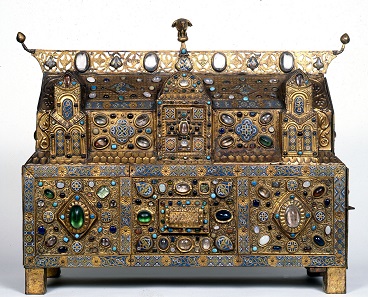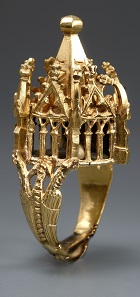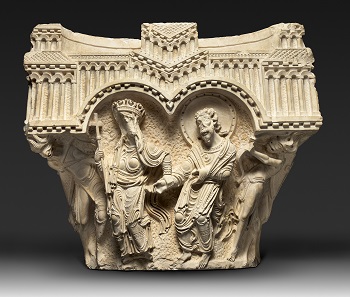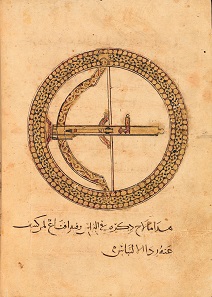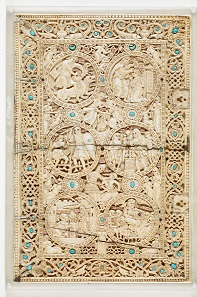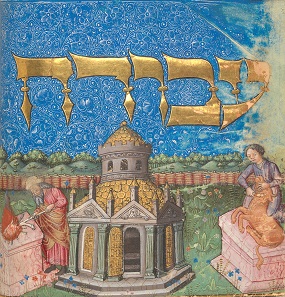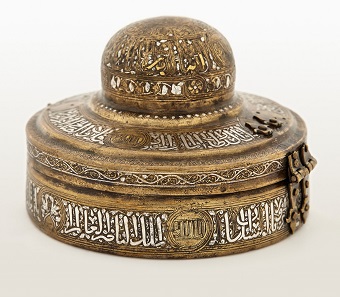December 22, 2016 – Beginning around the year 1000, Jerusalem attained unprecedented significance as a location, destination, and symbol to people of diverse faiths from Iceland to India. Multiple competitive and complementary religious traditions, fueled by an almost universal preoccupation with the city, gave rise to one of the most creative periods in its history. Running at the Tisch Galleries, Gallery 899 at The Metropolitan Museum of Art until January 8, 2017, the landmark exhibition “Jerusalem 1000-1400: Every People Under Heaven” will demonstrate the key role that the Holy City, sacred to the three Abrahamic faiths, played in shaping the art of this period. In these centuries, Jerusalem was home to more cultures, religions, and languages than ever before. Through times of peace as well as war, Jerusalem remained a constant source of inspiration that resulted in art of great beauty and fascinating complexity.
Coin Treasure. Gold. Early 11th century, Caesarea. Courtesy of the Israel Antiquities Authority, Jerusalem. (The large coins around the periphery are not in the exhibition.).
The exhibition is made possible by The David Berg Foundation; The al-Sabah Collection, Kuwait; the Sherman Fairchild Foundation; the William S. Lieberman Fund; The Polonsky Foundation; Diane Carol Brandt; The Andrew W. Mellon Foundation; the Ruddock Foundation for the Arts; and Mary and Michael Jaharis. Additional support is provided by the National Endowment for the Arts.
2
Chasse of Ambazac. From the Treasury of Grandmont. Limoges, ca. 1180-90. Gilded copper, champlevé enamel, rock crystal, semiprecious stones, faience, and glass. H. 23 1/8 in. (58.6 cm), W. 31 1/8 in. (79 cm), D. 101/4 in. (26.2 cm). Mairie d’Ambazac. Image: © Region Aquitaine-Limousin-Poitou-Charentes, Service de l’Inventaire et du Patrimoine Culturel (photograph by Philippe Rivière, 1993).
“Jerusalem 1000-1400: Every People Under Heaven” is the first exhibition to unravel the various cultural traditions and aesthetic strands that enriched and enlivened the medieval city. The exhibition will feature some 200 works of art from 60 lenders worldwide. More than four dozen key loans come from Jerusalem’s diverse religious communities, some of which have never before shared their treasures outside their walls
Exhibition Overview
The exhibition will examine six specific factors that made medieval Jerusalem an exceptional source of artistic inspiration:
Pair of Bracelets. Egypt or Greater Syria, 11th century. Repoussé gold sheet, wire, and granulation. a: W. 11/4 in. (3.2 cm), Diam. 23/4 in. (7 cm); b: W. 11/4 in. (3.2 cm), Diam. 2 5/8 in. (6.5 cm). The al-Sabah Collection, Dar al-Athar al-Islamiyyah, Kuwait (LNS 7 J ab). Image: © The al-Sabah Collection, Dar al-Athar al-Islamiyyah, Kuwait.
The Pulse of Trade and Tourism
Often understood as the crossroads of the known world, Jerusalem was a thriving urban center, teeming with locals and tourists, new arrivals and long-timers, merchants and artists, soldiers and scholars. The exhibition will evoke the many wares of the marketplace, including ceramics produced locally and imported from as far away as China. Textiles on view will reconstruct the fashion sensibilities of Jerusalem’s residents, including, surprisingly perhaps, their predilection for printed cottons from the Indian subcontinent. The shared taste of the region’s wealthy inhabitants confounds efforts to distinguish the owners’ identities, let alone their ethnic or religious heritage. Jewels that are recognizably Islamic in technique correspond to contemporary descriptions of the trousseaux of Jewish brides. A remarkable gathering of Cross reliquaries speak to the links between Jerusalem and Europe.
Jewish Wedding Ring. Germany, first half of the 14th century.Gold. H. 1 7/8 in. (4.8 cm), W. 1 in. (2.5 cm), D. 1 in. (2.5 cm). Thüringisches Landesamt für Denkmalpflege und Archäologie, Weimar (5067/98). Image: Thüringisches Landesamt für Denkmalpflege und Archäologie (photograph by B. Stefan).
The Diversity of Peoples
Dozens of denominations and communities contributed to the artistic and spiritual richness of the city. The historical record surrounding medieval Jerusalem – a “city of foreigners” – includes both harmonious and dissonant voices from many lands: Persians, Turks, Greeks, Syrians, Armenians, Georgians, Ethiopians, Indians, and Europeans from each of the Abrahamic faith traditions passed in the narrow streets of the city – not much larger than midtown Manhattan. Visitors will be astonished, for example, by the numerous distinct alphabets and different languages of prayer. Exemplifying this will be Christian Gospel books in Arabic, Greek, Armenian, and Syriac, a Samaritan Bible in a distinctive Hebrew script, and the biblical book of Kings in Ge’ez, the language of Ethiopia, given by that land’s king to his community in Jerusalem.
Mosque Lamp of Sultan Barquq. Egypt or Syria, 1382-99. Glass with gold and enamel. 133/4 °- 101/2 in. (34.7 °- 26.8 cm). Victoria and Albert Museum, London (321-1900). Image: © Victoria and Albert Museum, London.
The Air of Holiness
The exhibition will attempt to evoke the city’s sacred iconic monuments, with their layered history and shared spaces. Though Jerusalem can appear eternal, it has undergone enormous change. Seemingly immutable elements of Jerusalem’s sacred topography were understood differently in this period. Medieval maps show us that Christians understood the Muslim Dome of the Rock and the Aqsa Mosque to be the Ancient Temple and the Palace of Solomon, respectively. Manuscripts and rare documents demonstrate that medieval Jewish pilgrims focused most of their attention on the city’s gates and the Mount of Olives, rather than the Western Wall.
The Virgin and Apostle Capital 101e. The Saint Matthew Capital. Early 1170s. Limestone. 241/2°- 28 3/8° – 13 3/8 in. (62 °- 72 °- 34 cm). Terra Sancta Museum, Basilica of the Annunciation, Nazareth. Image: © Marie-Armelle Beaulieu /Custodia Terræ Sanctae.
Among the highlights of this section are five sculpted capitals from the Church of the Annunciation in Nazareth belonging to the Franciscan Community of Jerusalem. These pristinely preserved works, unearthed at the beginning of the 20th century, powerfully demonstrate the skill and imagination of the sculptors and the dramatic relationship between faith and art during the brief but exceptionally fertile Crusader period. Met conservator Jack Soultanian has prepared them for exhibition; this is the first time the ensemble has left Nazareth.
104. Saladin’s Treatise on Armor. Syria, before 1187. Opaque watercolor, gold, and ink on paper; 217 folios. H. 9 7/8 in. (25.2 cm), W. 7 5/8 in. (19.5 cm), D. 2 1/8 in. (5.5 cm). Bodleian Libraries, University of Oxford (MS Huntington 264).
The Drumbeat of Holy War
Intimately bound with the belief in Jerusalem’s sanctity and the sense of exclusive ownership it instilled is the ideology of Holy War. This period witnessed the intensification of both crusade in Christianity and jihad in Islam. The exhibition offers an important opportunity to present these concepts, so charged in our own day. Art was recruited to justify war, presenting it as beautiful and divinely sanctioned. A manuscript depicting weapons created for the great Islamic warrior Saladin presents them as exquisite goldsmith’s work while a sculpted effigy (newly-cleaned for the exhibition) depicts a French nobleman as a crusader in full battle armor for eternity.
121. Upper cover of The Psalter of Melisende, Queen of Jerusalem. Jerusalem, Scriptorium of the Holy Sepulchre, ca. 1135. Ivory with semiprecious stones and silk-embroidered spine. 81/2 °- 51/2 in. (21.6 °- 14 cm). British Library, London. Image: © The British Library Board.
The Generosity of Patrons
The exhibition will introduce visitors to some of the real men and women who altered the aesthetic landscape of the city. The name of Melisende, the Frankish-Armenian Queen of Jerusalem, is linked to a celebrated Psalter, which will be presented as a larger witness to her activity as a patron of churches and scriptoria. An unprecedented gathering of luxury metalwork will evoke the patronage of Al-Nasir Muhammad ibn Qala’un; this dazzling display appropriately conjures up the munificence of this most important Mamluk patron of Jerusalem.
Illustration (detail) from The Book of Divine Service. From the Mishneh Torah of Maimonides Illumination attributed to the Master of the Barbo Missal Scribe: Nehemiah for Moshe Anau be Yitzchak. Northern Italy, ca. 1457. Tempera, gold leaf and ink on parchment; 346 folios. Folio: 9 °- 71/4 in. (22.7 °- 18.4 cm). Jointly owned by the Israel Museum, Jerusalem, and The Metropolitan Museum of Art, New York, 2013. Purchased for the Israel Museum through the generosity of an anonymous donor; René and Susanne Braginsky, Zurich; Renée and Lester Crown, Chicago; Schusterman Foundation, Israel; and Judy and Michael Steinhardt, New York. Purchased for The Metropolitan Museum of Art with Director’s Funds and Judy and Michael Steinhardt Gift (2013.495). Image: © The Metropolitan Museum of Art, New York.
The Promise of Eternity
Finally, this is the first exploration of art that springs from the belief, common to Judaism, Christianity, and Islam, that Jerusalem stands at the gates of heaven. The exhibition will include masterpieces of Persian illumination that bear witness to the key role of the Holy City in the life of Muhammad and in the Muslim faith tradition. Alongside these will be Hebrew manuscripts in which the glittering implements of the Temple symbolize the longing for redemption. An imposing jeweled shrine represents the Heavenly Jerusalem as Christian imagined it.
Incense Box. Egypt or Syria, 14th century. Brass, gold, silver, and black compound. H. 2 7/8 in. (7.5 cm), Diam. 41/2 in. (11.5 cm). Museum of Islamic Art, Doha (MW.468.2007). Image: The Museum of Islamic Art, Doha.
To bring the city to life and to create a truly immersive experience, the installation will feature specially commissioned videos that provide subtle glimpses, as through windows, of the varied and colorful panorama of Jerusalem with its ever-present medieval monuments. Complementing the videos are short interviews with some of the fascinating men and women who maintain the city’s medieval legacy.
Catalogue
A lavishly illustrated catalogue appropriate for specialists and general readers alike will accompany the exhibition. More than fifty scholars from the United States, Europe, and the Middle East have contributed to the catalogue. Published by The Metropolitan Museum of Art and distributed by Yale University Press, the book will be available in The Met Shop (hardcover, $75.).
The catalogue is made possible by The Andrew W. Mellon Foundation; the Michel David-Weill Fund; Tauck Ritzau Innovative Philanthropy; the Ruddock Foundation for the Arts; Christopher C. Grisanti and Suzanne P. Fawbush; and Helen E. Lindsay.
The exhibition will be featured online, as well as on Facebook, Instagram, and Twitter via the hashtag #MetJerusalem.






